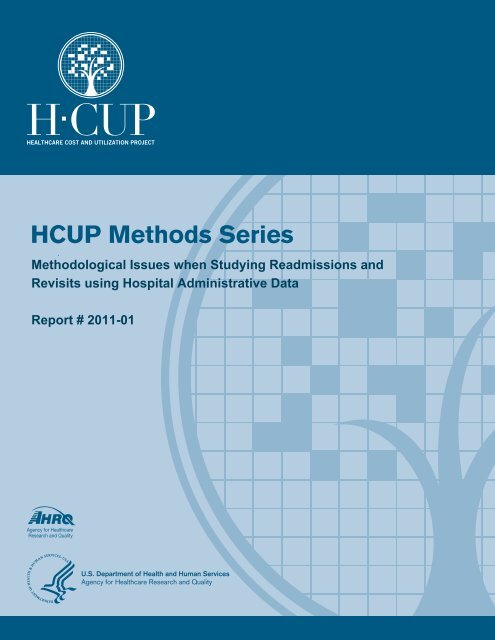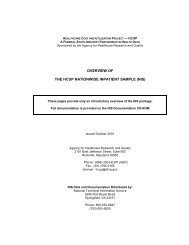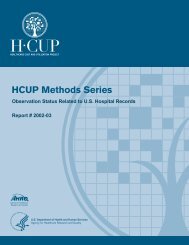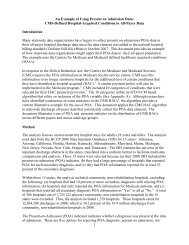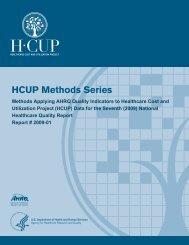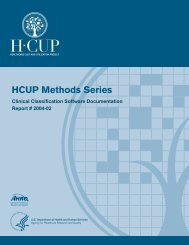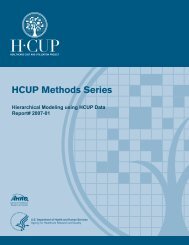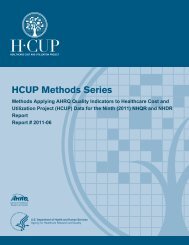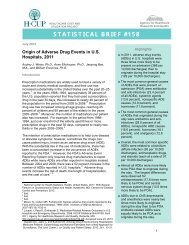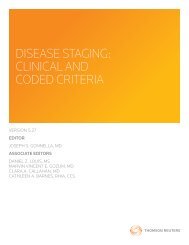Methodological Issues when Studying Readmissions and ... - HCUP
Methodological Issues when Studying Readmissions and ... - HCUP
Methodological Issues when Studying Readmissions and ... - HCUP
Create successful ePaper yourself
Turn your PDF publications into a flip-book with our unique Google optimized e-Paper software.
<strong>HCUP</strong> Methods Series
Contact Information:Healthcare Cost <strong>and</strong> Utilization Project (<strong>HCUP</strong>)Agency for Healthcare Research <strong>and</strong> Quality540 Gaither RoadRockville, MD 20850http://www.hcup-us.ahrq.govFor Technical Assistance with <strong>HCUP</strong> Products:Email: hcup@ahrq.govorPhone: 1-866-290-<strong>HCUP</strong>Recommended Citation: Barrett M, Steiner C, Andrews R, Kassed C, Nagamine M.<strong>Methodological</strong> <strong>Issues</strong> <strong>when</strong> <strong>Studying</strong> <strong>Readmissions</strong> <strong>and</strong> Revisits Using HospitalAdminstrative Data. 2011. <strong>HCUP</strong> Methods Series Report # 2011-01. ONLINE March 9, 2011.U.S. Agency for Healthcare Research <strong>and</strong> Quality. Available: http://www.hcupus.ahrq.gov/reports/methods/methods.jsp.
TABLE OF CONTENTSIntroduction ................................................................................................................................. 1Terminology ................................................................................................................................ 1Analytic Considerations for Data Preparation ......................................................................... 2Selecting the Appropriate Administrative Database .................................................................. 2Consistency of Person-Specific Identifiers (PIDs) ................................................................. 2Selecting the Hospital Settings for a Revisit Analysis ............................................................ 3Deciding on the Number of Data Years to Include ................................................................ 3Identifying the Time between Hospital Visits ......................................................................... 3H<strong>and</strong>ling Multiple Records Representing Sequential Hospital Events on the Same Day ......... 4Reasons to Collapse Same-Day Hospital Records into One Combined Record ................... 6Reasons to Retain Same-Day Hospital Events as Separate Records .................................. 6Categorizing Patients for a Revisit Analysis .............................................................................. 6Categorizing Patients by Patient Characteristics ................................................................... 6Categorizing Patients by Hospital Characteristics ................................................................. 7Categorizing Patients by Insurance Status ............................................................................ 7Analytic Considerations for Defining Revisits ......................................................................... 8Defining the Starting Point ......................................................................................................... 8Specifying the Criteria for a Revisit ........................................................................................... 8Selecting the Time Period for Revisits ...................................................................................... 9Defining a “Clean Period” Prior to the Index Event ................................................................. 10Analytic Considerations for Reporting Revisit rates ............................................................. 11Conclusion ................................................................................................................................ 11Appendix A. <strong>HCUP</strong> Data Partners ......................................................................................... A-1Appendix B. Summary Counts of Reviewed Journal Articles ............................................ B-1Appendix C. Literature Review: Studies of Repeat Hospital Visits .................................... C-1Goals of Literature Review ........................................................................................................ 1Review Methods ........................................................................................................................ 1List of Relevant Articles ............................................................................................................. 2Studies Using <strong>HCUP</strong> Data ........................................................................................................ 7<strong>HCUP</strong> (02/25/11)Method Series on Readmission <strong>and</strong> Revisit Analyses
INTRODUCTIONReducing repeat acute care hospital visits is a key strategy for improving the quality of healthcare, while reducing the cost of care. Depending on the severity <strong>and</strong> complexity of theunderlying condition, a patient may be readmitted as an inpatient (IP) to the hospital, seenfrequently in the emergency department (ED), or admitted to the hospital after an ambulatorysurgery (AS) visit. Devising effective strategies to reduce the rate of multiple acute care hospitalvisits by the same person requires a thorough underst<strong>and</strong>ing of the factors that contribute torepeat visits. However, studying patients that repeatedly use or cross between the IP, ED, <strong>and</strong>AS settings is difficult for a myriad of reasons, including a lack of reliable patient identifiers thatenable tracking of patients in hospital administrative data, as well as privacy concerns.Sequential hospital visits may occur for any reason <strong>and</strong> can be separated by days, weeks,months or years. Multiple hospital visits by the same patient may, in fact, be unrelated. <strong>Studying</strong>related visits can be difficult as researchers must underst<strong>and</strong> whether patients are seen in thehospital for expected follow-up treatment, or conversely, for unexpected complications. ThisMethods Series Report discusses the decisions that need to be addressed as an analystdesigns a study of patients with sequential acute care hospital visits that is based on hospitaladministrative data. Topics include considerations in preparing the administrative database forthe analysis, defining repeat hospital visits, <strong>and</strong> reporting results. This report provides specificexamples using <strong>HCUP</strong> administrative data. However, the examples are illustrative <strong>and</strong> most arealso applicable to other administrative data.To examine variation in designing readmission analyses, we compiled list of 72 journal articlespublished between January 2000 <strong>and</strong> November 2010 that used U.S. hospital administrativedata to study repeat hospital visits (see Appendix C). This information is supplemented byexamples from the Healthcare Cost <strong>and</strong> Utilization Project (<strong>HCUP</strong>) databases, sponsored by theAgency for Healthcare Research <strong>and</strong> Quality (AHRQ). <strong>HCUP</strong> recently augmented its state-leveldatabases with data elements that allow tracking a patient across time <strong>and</strong> hospital setting whileadhering to strict privacy regulations. <strong>HCUP</strong> features the largest collection of multi-year hospitalcare data in the United States, containing a wealth of all-payer, encounter-level informationbeginning in 1988. Analyses of repeat hospital visits are possible on select <strong>HCUP</strong> StateInpatient Databases (SID), State Emergency Department Databases (SEDD), <strong>and</strong> StateAmbulatory Surgery Databases (SASD) beginning with 2003 data. Appendix A contains the listof data organizations that participate in the <strong>HCUP</strong> state databases. Not all states that participatein <strong>HCUP</strong> collect the information necessary to track a patient across hospital settings <strong>and</strong> time.TERMINOLOGYBefore discussing the issues involved in designing a study of repeat acute care hospital visits,common terminology is defined.• Synthetic person-specific identifier (PID) – a unique string of characters (numbers <strong>and</strong>/orletters) that can be used to track patients across time <strong>and</strong> hospital settings. While a PIDis often based on some combination of patient’s social security number, date of birth,gender, or name, the actual synthetic PID cannot be directly linked back to the person.• Index event – starting point for analyzing repeat hospital visits.• <strong>Readmissions</strong> – repeat inpatient admissions within a specified time period.<strong>HCUP</strong> (02/25/11)1Method Series on Readmission <strong>and</strong> Revisit Analyses
• Revisits – repeat hospital visits within a specified time period. May include a mixture ofinpatient, emergency department, <strong>and</strong>/or hospital-based ambulatory surgery visits.ANALYTIC CONSIDERATIONS FOR DATA PREPARATIONAnalytic considerations for preparing administrative data for an analysis of repeathospitalizations include:• Selecting the appropriate administrative database – This section includes a discussionon checking the consistency of person-specific identifiers, selecting the appropriatehospital-settings for a revisit analysis, deciding on the number of data years to include,<strong>and</strong> identifying the time between hospital visits.• H<strong>and</strong>ling sequential hospital events on the same day events – This section includesrationale for <strong>when</strong> to retain same day hospital events as separate records <strong>and</strong> <strong>when</strong> tocollapse the information about the events into one combined record.• Categorizing patients <strong>when</strong> characteristics can change over time – This sectiondiscusses categorizing patients by patient characteristics, hospital characteristics, <strong>and</strong>insurance status.Each topic is discussed in turn.Selecting the Appropriate Administrative DatabaseWe reviewed journal articles that described studies in which different types of administrativedatabases were used: national databases such as Medicare claims data, state-level databasessuch as <strong>HCUP</strong>, local data on a group of hospitals or a single hospital, or other focused data forspecific populations such as Veterans. Almost thirty percent of the studies used nationaldatabases, 26 percent used state-level databases, <strong>and</strong> 32 percent used local data. Appendix Bpresents summary counts of the reviewed articles by data source. One limitation of state-leveldatabases is the inability to track residents that receive treatment in other states. In contrast,databases such as Medicare claims provide information for patients from all states, but only forone type of insurance (i.e., Medicare fee-for-service).Additional considerations in selecting an appropriate database for a study of multiple hospitalvisits include:• Consistency of PID coding across years• Selection of the hospital setting• Time span covered by available data• Availability of sufficient information on the timing between hospital visits.Consistency of Person-Specific Identifiers (PIDs)The selected database used for an analysis of repeat hospitalizations needs to haveconsistently coded PIDs throughout study period <strong>and</strong> across hospital settings, if more than onesetting is to be included in the analysis. For the <strong>HCUP</strong> state databases, PIDs (“termed VisitLink”for visit linkage number) are verified against gender <strong>and</strong> date of birth in the creation of a reidentifiedPID to ensure consistency across data years <strong>and</strong> hospital setting. 11 Overview of the <strong>HCUP</strong> Supplemental Files for Revisit Analyses available at http://www.hcupus.ahrq.gov/toolssoftware/revisit/revisit.jsp<strong>HCUP</strong> (02/25/11)2Method Series on Readmission <strong>and</strong> Revisit Analyses
Inconsistencies in PIDs across calendar years of data still exist because <strong>HCUP</strong> data partnershave changed their coding schemes. Between 2004 <strong>and</strong> 2007, four of the 17 states that havesynthetic person identifiers in the <strong>HCUP</strong> state databases have refined their creation of syntheticPIDs because of differing interpretations of how to apply the Health Insurance Portability <strong>and</strong>Accountability Act (HIPAA) restrictions to the release of this type of person-related information.Even if the PIDs are consistently coded across years <strong>and</strong> hospital settings, it is advisable toconfirm that PIDs are consistently coded for the population of interest (e.g., age, insurance,hospital type, etc.). For example, in the <strong>HCUP</strong> state databases, there is limited availability inPIDs for pediatric patients in some states, but good availability (greater than 90 percent) foradult patients in all possible states. Availability of PIDs for patients covered by different types ofinsurance can also vary by state. 2Selecting the Hospital Settings for a Revisit AnalysisWhen studying repeat hospital care, careful consideration needs to be given to the choice ofhospital settings. Many studies have focused on inpatient readmissions, but that may not alwaysprovide the most complete picture of hospital care. For example, if studying a chronic conditionsuch as asthma it might be advantageous to include inpatient stays <strong>and</strong> emergency departmentvisits that do not result in admission because treatment for asthma occurs in both settings. Ifstudying inpatient treatment for an acute condition such as acute myocardial infarction (AMI), itmight be interesting to look forward in time at inpatient readmissions or back in time for anemergency department visit in which the heart condition was misdiagnosed. In addition,complications of ambulatory or short-stay surgery may present in the emergency department<strong>and</strong> be stabilized <strong>and</strong> released home or admitted to the hospital.The majority of the journal articles we reviewed (69 percent) studied only inpatientreadmissions. Another 17 percent utilized both inpatient <strong>and</strong> outpatient data. Summary countsare shown in Appendix B.Deciding on the Number of Data Years to IncludeThe number of data years to be included in a study period for an analysis of revisits depends onthe time interval that will be allowed between multiple visits. For example, in a study of repeathospital visits within three months that uses only one calendar year of data, events of interestcan only be identified for the first nine months of the year (January through September). Thelast three months (October through December) are reserved for identifying the repeat visits forpatients with a first event during the June to September period. If the event of interest is rare, acalendar year study period may be insufficient to obtain an adequate sample size. About half ofthe journal articles we reviewed (47 percent) used a time period of three or more years. Twentyeightpercent used a one year study period. The lengths of study periods used in studies wereviewed are detailed in Appendix B.Identifying the Time between Hospital VisitsThe final consideration in choosing an appropriate administrative database to study revisits isthe availability of information on the time interval between hospital events. Because of HIPAAguidelines on protecting patient confidentiality, dates of admission, discharge, <strong>and</strong> treatment are2 Steiner, C. (AHRQ), Barrett, M. (M.L. Barrett, Inc.), <strong>and</strong> Hunter, K. (Thomson Reuters). Hospital<strong>Readmissions</strong> <strong>and</strong> Multiple Emergency Department Visits, in Selected States, 2006–2007.. <strong>HCUP</strong>Statistical Brief #90. May 2010. Agency for Healthcare Research <strong>and</strong> Quality, Rockville, MD.http://www.hcup-us.ahrq.gov/reports/statbriefs/sb90.pdf. (Accessed August 7, 2010).<strong>HCUP</strong> (02/25/11)3Method Series on Readmission <strong>and</strong> Revisit Analyses
not releasable on publicly available administrative databases. In the absence of actual dates,there needs to be alternative information on timing between hospital visits. Administrativedatabases often limit timing information to months (e.g. admit month or discharge month) whichcan hinder analyses of revisits within shorter time periods such as 7 or 14 days. To facilitaterevisit analyses, <strong>HCUP</strong> has created a timing variable that can be used to identify the actualnumber of days between hospital visits while adhering to strict privacy guidelines. 3H<strong>and</strong>ling Multiple Records Representing Sequential Hospital Events on the Same DayHospital administrative databases are often characterized as being “discharge-level” files,meaning that each record represents one discharge abstract from a hospital setting, which canbe an IP, ED, or AS visit. If the same individual visits the hospital multiple times in a given year,the administrative database includes separate records for each visit. For example, if a patient isseen in the ED <strong>and</strong> sent home, then there is one ED record. If later in the year, the patient isadmitted to the hospital, there is a separate IP record. If the inpatient stay resulted in beingtransferred to another hospital, there are two separate IP records.Transfers are a specific type of same-day event in which there is a discharge disposition oftransfer out on the first hospital record <strong>and</strong> an admission source that indicates a transfer into thehospital on the second hospital record. Same-day events that are not transfers are alsopossible. These are defined by multiple records in which the discharge date of one hospitalrecord is the same as the admission date of a different hospital record, but the discharge status<strong>and</strong> admission source do not indicate a transfer. It is also possible that the multiple visits dooccur on the same day because one event ends near midnight <strong>and</strong> the second event starts thenext day in the early morning. When studying sequential hospital visits, one might argue thatthese multiple records represent one hospital event, even if that is not how they are representedin the administrative database. This section includes information on the frequency of thesetypes of events based on <strong>HCUP</strong> data <strong>and</strong> rationale for <strong>when</strong> to retain same day hospital eventsas separate records <strong>and</strong> <strong>when</strong> to collapse the events into one combined record.The 2007 <strong>HCUP</strong> state databases were used to examine the effect of different schemes foridentifying transfers <strong>and</strong> same-day events <strong>and</strong> the variation in occurrence across states. Weused the 2007 State Inpatient Databases (SID), State Emergency Department Databases(SEDD), <strong>and</strong> State Ambulatory Surgery Databases (SASD) to examine four types of events:1. IP-to-IP events involving an inpatient record that ends on the same day anotherinpatient record starts.2. ED-to-IP events involving an emergency department record that ends on the same dayan inpatient record starts.3. ED-to-ED events involving an emergency department record that ends on the same dayanother emergency department record starts.4. AS-to-IP events involving an ambulatory surgery record that ends on the same day aninpatient record starts.The 2007 <strong>HCUP</strong> SID for 15 states combined were used to examine the change in thepercentage of records identified as same-day events using different combinations of threepossibly helpful data elements: discharge disposition, admission source, <strong>and</strong> timing (Table 1). Itshould be noted that sequential events that go through the night were not considered in the3 More information about the <strong>HCUP</strong> supplemental variables for revisit analyses is available on the <strong>HCUP</strong>User Support Web site (http://www.hcup-us.ahrq.gov/toolssoftware/revisit/revisit.jsp).<strong>HCUP</strong> (02/25/11)4Method Series on Readmission <strong>and</strong> Revisit Analyses
example because only a few <strong>HCUP</strong> databases include information on the hour the hospital visitstarted <strong>and</strong> stopped.The strictest criteria for looking at same-day transfers required a discharge disposition oftransfer out on the first hospital record <strong>and</strong> a second hospital record on the same day with anadmission source that indicated a transfer into the hospital. In pooled data from the 2007 SID for15 states, less than one percent of the inpatient discharges were identified as IP-to-IP same-dayevents. In the other data combinations, there were less than 0.1 percent of records identified assame-day events.The next criteria excluded the use of admission source in identifying same-day events becausethis data element was often unavailable on ED <strong>and</strong> AS records. This increased the percentageof records identified as follows: IP-to-IP same-day events increased from 0.8 to 1.3 percent, EDto-IPsame-day events increased from 0.1 to 0.5 percent, ED-to-ED same-day events increasedfrom 0.0 to 0.1 percent, <strong>and</strong> AS-to-IP same-day events remained near zero percent.The last criteria used only timing to identify same-day events <strong>and</strong> disregarded the dischargedisposition <strong>and</strong> admission source. The percentage of records identified as same-day eventsmore than doubled: IP-to-IP same-day events increased from 1.3 to 3.1 percent, ED-to-IPsame-day events increased from 0.5 to 1.0 percent, ED-to-ED same-day events increased from0.1 to 1.5 percent, <strong>and</strong> AS-to-IP same-day events increased from 0.04 to 0.13 percent.Table 1. Percentage of Records Identified as Same-Day EventsIP-to-IPsame-dayeventsPercentage(15 States)ED-to-IPsame-dayeventsPercentage(12 States)ED-to-EDsame-dayeventsPercentage(12 States)AS-to-IPsame-dayeventsPercentage(10 States)Scheme to identify sameday eventsTwo records – the first recordhas a discharge dispositionthat indicates a transfer out<strong>and</strong> the second record0.8% 0.1% 0.0% 0.02%includes an admission sourceof transferred into the hospitalon the same dayTwo records – the first recordhas a discharge dispositionthat indicates a transfer out<strong>and</strong> the second record starts1.3% 0.5% 0.1% 0.04%on the day of discharge (Nouse of admission source)Two records in which the firsthospital record indicates adischarge on the same dayas a second record shows an 3.1% 1.0% 1.5% 0.13%admission (No use ofdischarge disposition oradmission source)Source: Agency for Healthcare Research <strong>and</strong> Quality, Center for Delivery, Organization, <strong>and</strong> Markets,Healthcare Cost <strong>and</strong> Utilization Project, State Inpatient Databases, State Emergency DepartmentDatabases, <strong>and</strong> State Ambulatory Surgery Databases, 2007.<strong>HCUP</strong> (02/25/11)5Method Series on Readmission <strong>and</strong> Revisit Analyses
There are two options for h<strong>and</strong>ling multiple records in an administrative database that representa same-day event -- collapse to create one record or retain separate records. Selection of thebest approach depends on the intent of the study.Reasons to Collapse Same-Day Hospital Records into One Combined RecordIf the multiple same-day event records are combined into a summary record, then a study ofrevisits will consider the care received in the hospital as one event. When combining themultiple hospital records that represent a same-day event, consider retaining the hospitalidentifier from latter record to credit this hospital with the care, summing the length of stay <strong>and</strong>total charges to capture the total utilization, retaining the diagnoses <strong>and</strong> procedure codes fromboth records, but assigning the principal diagnosis from latter record. If there is evidence of EDservices reported on the first record, then it might be helpful to also retain that information. Thisapproach gives more complete picture of resources to treat a certain medical condition.Reasons to Retain Same-Day Hospital Events as Separate RecordsIf the multiple same-day event records are kept separate, a study of revisits will consider thesecond record a second event. Keeping the records separate, will allow the analysis to considerthe initial severity at the first event as a predictor of future revisits. In addition, if the records arekept separate, the analysis can consider whether the care at the first or second hospital mighthave contributed to later hospital revisits.Categorizing Patients for a Revisit AnalysisRevisit studies frequently report information by patient demographics, hospital characteristics, orinsurance status. Because these characteristics can change over the study period, decisionsneed to be made on how to assign the reporting categories. This section discusses possibleapproaches to categorizing patients by different patient characteristics, hospital characteristics,<strong>and</strong> insurance status.Categorizing Patients by Patient CharacteristicsHow to categorize a patient depends on how variable the information may be over the studyperiod. When categorizing patients in a revisit study based on information that is constant overthe study period, such as gender, any occurrence of a patient in the administrative databasecan be used. For computer programming, it is easiest to use the first occurrence.When categorizing patients based on information for which change is predictable, such as age,the analyst needs to decide whether it is appropriate to use the earliest or latest event tocategorize the patient.When categorizing patients in a revisit study based on information for which change is possible,but not predictable, the expected frequency of change during the study period <strong>and</strong> the intent ofthe analysis should be considered. For example, <strong>when</strong> assigning the urban/rural location of thepatient’s residence, consider the length of the study period. If the period is short, such as oneyear, then using the location of the first occurrence of the patient is reasonable. If the studyperiod is longer, with duration of 5 years, for example, then the location of the majority of theoccurrences may be more appropriate. In the case of the race/ethnicity of the patient, then theracial group reported most frequently may be most representative, given that the collection ofthis information can be unreliable (though inconsistency in race/ethnicity coding could be asignal that the patient has a multi-racial background).<strong>HCUP</strong> (02/25/11)6Method Series on Readmission <strong>and</strong> Revisit Analyses
Categorizing Patients by Hospital CharacteristicsCategorizing patients by hospital characteristics needs to be consistent with the purpose of theanalysis. For example, <strong>when</strong> studying hospital care for patients treated for severe injuries, thehospital responsible for the initial treatment of the trauma is essential to the study. Thisassignment can be complex because severely injured patients are often transferred to a moreadvanced trauma center. Consider a possible two-step process to categorizing use of traumahospitals for treating severe injuries:• Did the initial treatment occur within a single hospital?o If yes, categorize the event by the trauma level of the single treatment facility.o If no, categorize the event by whether the transfer was to a higher, lower, orsimilar trauma level facility.Categorizing Patients by Insurance StatusCategorizing patients by insurance status also needs to be consistent with the purpose of theanalysis. The expected payer reported on administrative data is specific to one point in time.Over the course of a year or multiple years, a patient can be covered by different types ofinsurance. Options for categorizing patients by type of insurance over time include the following:• Selecting the expected payer for the index event• Choosing the expected payer for the revisit• Using a hierarchical assignment that considers all events• Opting for an “if ever” approach.If the payer of the index event is used, then the analysis might focus on the effect of insuranceon quality of care. In contrast, in a study of how insurance affects other reasons for seeking areadmission (e.g., unavailable care or financial issues in management of care outside thehospital), the insurance group at readmission might be more relevant. Consider a family thatlost their insurance <strong>and</strong> then had “self-pay” at a revisit.A hierarchical approach assigns a preference in the assignment of payer. Consider the followingexample that assigns priority to Medicare, then Medicaid, then private insurance, <strong>and</strong> lastlyuninsured:• If any hospital visit is coded with Medicare as the expected payer, then assign thepatient to Medicare.• If no hospital visit is covered by Medicare, then assign the patient to Medicaid if anyhospital visit is coded with Medicaid as the expected payer.• If no hospital visit is covered by Medicare or Medicaid then assign patient to privateinsurance if any hospital visit is coded with private insurance as the expected payer.• If no hospital visit is covered by Medicare, private insurance, or Medicaid, then assignpatient to other insurance if any hospital visit is coded with another type of governmentor local payer.• If no hospital visit is covered by insurance (Medicare, private insurance, Medicaid, orother) then assign patient to uninsured.<strong>HCUP</strong> (02/25/11)7Method Series on Readmission <strong>and</strong> Revisit Analyses
Medicare <strong>and</strong> Medicaid are considered before private insurance because Medicare <strong>and</strong>Medicaid programs are sometimes reported under a private insurance group contracted to coverMedicare or Medicaid patients. This can especially be true for Medicare HMO programs.The “if ever” approach to categorizing a patient by type of insurance, considers all hospital visitsfor a patient. A simple dichotomous scheme divides patients into two groups: uninsured (at leastone hospital visit is uninsured) versus insured (all hospital visits in the study period are coveredby some type of insurance). A more detailed categorization of the insured would separatepatient for which all hospital visits were covered by Medicare, Medicaid, private, or somecombination of insurance.ANALYTIC CONSIDERATIONS FOR DEFINING REVISITSAnalytic considerations for defining revisits include the following:• Defining the starting point of the study• Specifying the criteria for a revisit• Selecting the appropriate time period for revisits,• Determining a clean period, if necessary, prior to the starting point.Each topic is discussed in turn.Defining the Starting PointThe starting point of a revisit study is often called the “index event” <strong>and</strong> refers to the firstoccurrence of the event of interest. The event of interest is typically defined by a combination ofclinical criteria <strong>and</strong> hospital setting. Clinical criteria can include, but are not limited to,diagnoses, procedures <strong>and</strong> a discharge disposition of alive. The index event can occur duringan inpatient stay, emergency department visit, or ambulatory surgery.Possible exclusion criteria include the following:• Index events in which the patient died in the hospital because there is no risk ofreadmission.• Same day events that were combined into a single record during the data preparationbecause it represents a more complex situation.The exclusion of certain types of patients may also be appropriate for certain revisit analyses.For example, if using a state-specific database, then patients that reside in another state shouldbe excluded. In addition, it might be appropriate to exclude patients with cancer or in animmunocompromised state because these conditions would greatly increase the risk of repeathospital care.Specifying the Criteria for a RevisitRevisit analyses tend to consider one of the following: any subsequent event regardless ofcause, any subsequent event that does not involve trauma, or any subsequent event only if theevent is “related” to the index event. The selection of criteria can dramatically change results.<strong>HCUP</strong> SID for 2007 from 15 states combined were used to examine the difference in 30-dayreadmission rates for two conditions, congestive heart failure (CHF) <strong>and</strong> asthma, by different<strong>HCUP</strong> (02/25/11)8Method Series on Readmission <strong>and</strong> Revisit Analyses
criteria (Table 2). The index event was defined by an adult inpatient admission with a specificprincipal diagnosis in which the patient is discharged alive. The Clinical Classification Software(CCS) 4 was used to identify the conditions: CCS 108 for a diagnosis of CHF <strong>and</strong> CCS 128 for adiagnosis of asthma. The three criteria for a readmission within 30 days include an inpatientstay with a principal diagnosis of the condition, a stay with a principal or secondary diagnosis ofthe condition, or any admission regardless of diagnosis. The percentage of patients with a 30-day readmission doubled <strong>when</strong> the criteria were broadened from a subsequent stay with aprincipal diagnosis of interest to a principal or secondary diagnosis of interest (9.8 to 22.1percent for CHF patients <strong>and</strong> 4.8 to 9.5 percent for asthma). For asthma, the percentage ofpatients with a 30-day readmission tripled <strong>when</strong> the criteria were further broadened to anyadmission (4.8 to 14.3 percent).Table 2. Percentage of Patients Identified as Having a 30-Day Readmission using ThreeDifferent CriteriaScheme to identify 30-dayCongestive HeartreadmissionFailureAsthmaPercentage of patients with areadmission within 30 days with the9.8% 4.8%same principal diagnosisPercentage of patients with areadmission within 30 days with thesame diagnosis as a principal or22.1% 9.5%secondaryPercentage of patients with areadmission within 30 days with any25.4% 14.3%diagnosisSource: Agency for Healthcare Research <strong>and</strong> Quality, Center for Delivery, Organization, <strong>and</strong> Markets,Healthcare Cost <strong>and</strong> Utilization Project, State Inpatient Databases, 15 States, 2007.Selecting the Time Period for RevisitsIn the above example, a readmission was identified as occurring within 30 days of the indexevent. A different time after the index event (e.g., 7 days, 14 days, 3 months, 1 year etc.) maybe appropriate depending on the analysis.When selecting an appropriate time period for the revisits, consider selecting a time that allowsfor the same risk of exposure of all patients, seasonality of the disease, <strong>and</strong> possible externalfactors. Shorter time frames (7 or 14 days) are often used to make events attributable tohospital acute care (IP, ED or AS) while longer time frames may reflect differences inambulatory care <strong>and</strong>/or coordination of care.<strong>HCUP</strong> SID <strong>and</strong> SEDD for 2007 from 13 states combined were used to examine the difference inany-cause revisit rates using different time frames for adult patients who were treated in the EDfor nonspecific chest pain (CCS 102) but not admitted at that time (Table 3). Within one week ofthe initial ED visit for chest pain, 93.1 percent of the patients had not been seen back in an EDor admitted; within two weeks, 89.8 percent of the patients had not been seen back in ahospital; <strong>and</strong> in one month, the percentage of patients not seen back at a hospital drops to 84.6percent. Within one week, 2.3 percent of the patients were admitted to the hospital for any4 Overview of the Clinical Classification Software available at http://www.hcupus.ahrq.gov/toolssoftware/ccs/ccs.jsp<strong>HCUP</strong> (02/25/11)9Method Series on Readmission <strong>and</strong> Revisit Analyses
cause. Within one month, the percentage of patients admitted more than doubled to 5.3 percent.The percentage of patients seen again in the ED (for any cause) more than doubled from oneweek to one month, increasing from 4.8 to 11.5 percent respectively.Table 3. Percentage of Patients Rehospitalized after Treatment in the ED for Chest Pain inThree Different Time PeriodsNumber of Percent ofPatients TotalAdult patients with an ED visit for chest pain in January toNovember 2007 that were not admitted to the hospital at thattime493,293 100.0%Within one week of the initial ED visitPatients with no hospital visits (IP or ED) 459,080 93.1%Patients admitted to a hospital for any cause 11,559 2.3%Patients seen in the ED for any cause <strong>and</strong> not23,786 4.8%admittedWithin two weeks of the initial ED visitPatients with no hospital visits (IP or ED) 443,026 89.8%Patients admitted to a hospital for any cause 17,205 3.5%Patients seen in the ED for any cause <strong>and</strong> not35,934 7.3%admittedWithin one month of the initial ED visitPatients with no hospital visits (IP or ED) 417,534 84.6%Patients admitted to a hospital for any cause 26,291 5.3%Patients seen in the ED for any cause <strong>and</strong> not56,507 11.5%admittedSource: Agency for Healthcare Research <strong>and</strong> Quality, Center for Delivery, Organization, <strong>and</strong> Markets,Healthcare Cost <strong>and</strong> Utilization Project, State Emergency Department Databases <strong>and</strong> State InpatientDatabases, 13 States, 2007.Defining a “Clean Period” Prior to the Index EventIn some revisit studies it may be appropriate to define a “clean” period of time at the beginningof the study period for which no event, either index or subsequent hospitalization, will beidentified.Consider two separate studies of 30-day readmissions for diabetes in a calendar year. In bothstudies, the index event is an adult admission with a principal diagnosis of diabetes in which thepatient is discharged alive. The readmission criteria are subsequent admissions with a principaldiagnosis of diabetes within a month (30 days). One option is to count patients from thebeginning of the year. Programming code would look for the first index event for a person fromJanuary to November. This allows an equal 30-day window from each index event to search fora readmission. Patients with an index event in November can be followed into December. Thereadmission rate would be the number of patients with at least one readmission for diabeteswithin 30 days divided by the number of patients with an admission for diabetes in 11 months.This approach possibly counts a true readmission in January as an index event, because datawas not available in December of the previous year. A second option is to define a “cleanperiod” prior to selecting the index event that is the same length as the readmission time period.This would mean modifying the approach described above by excluding patients with an eventin January. This guarantees that all index events had no prior admission for diabetes within 30days. The readmission rate would then be the number of patients with a readmission fordiabetes within 30 days divided by all patients with an admission for diabetes in 10 months.<strong>HCUP</strong> (02/25/11)10Method Series on Readmission <strong>and</strong> Revisit Analyses
Clean periods can also be used <strong>when</strong> allowing a patient to be counted multiple times in thestudy period. Consider a study of multiple ED visits for pediatric asthma within a month over afive-year study period. Given the long study period <strong>and</strong> the chronic nature of asthma, it isreasonable to count a patient multiple times. In this case, an ED visit would be considered anindex event only if the child had a diagnosis of asthma <strong>and</strong> there is no ED visit for asthma in theprior 30 days. The revisit rate in this study would be the number of times pediatric asthmapatients revisited the ED for asthma treatment within 30 days divided by the number of times inthe five-year period that pediatric patients visited the ED for asthma treatment without a priorasthma ED event in 30 days. A child with an ED visit on February 20, March 2, March 15, <strong>and</strong>November 10, would be counted once in the numerator for the March 2nd revisit <strong>and</strong> twice inthe denominator for the two index events (February 20 <strong>and</strong> November 10).Studies that count all patient revisits regardless of cause do not typically include a clean period.In this case, each visit for a patient is considered an index event. A subsequent visit within aspecified time period, such as 30 days, is counted as a revisit. Using the example above of achild with an ED visit on February 20, March 2, March 15, <strong>and</strong> November 10, all four visitswould be considered an index events (the denominator of the revisit rate) <strong>and</strong> two visits (March2 <strong>and</strong> March 15) would be counted as revisits (the numerator of the revisit rate) because theyfall within 30 days of an index event.ANALYTIC CONSIDERATIONS FOR REPORTING REVISIT RATESWhen reporting utilization of services such as IP stays or ED visits, it is beneficial to includeboth patient-level <strong>and</strong> event-level counts. The comparison of event <strong>and</strong> patient counts allowsthe analyst to judge if the change (i.e., increase or decrease) in utilization is driven by a changein the number of patients or the overuse of services by a small number of patients. Consider thefollowing example of ED visits for abdominal pain in two hospitals. In hospital A, there are10,000 ED visits each year, <strong>and</strong> the number of patients is about 8,000 annually. In hospital B,there are also 10,000 ED visits for abdominal pain each year, but the number of patientschanges from 8,000 in year 1 to 6,000 in year 2. In hospital B, the revisit rate of patients beingtreated for abdominal pain is actually increasing.Stratification of revisit rates may also be beneficial. Pediatric cases may have different revisitrates than adults with the same condition. If looking at all-cause inpatient readmissions,obstetric <strong>and</strong> newborn discharges may have very different readmission rtes than non-obstetric<strong>and</strong> non-newborn discharges.Severity or risk adjustment may also be beneficial <strong>when</strong> comparing revisit rates acrossgeographical regions, hospital, or different patient populations. A simple risk adjustment wouldinclude age <strong>and</strong> gender. A more complex adjustment might also include comorbidites, severityclassified by the 3M All Patient Refined DRG (APR DRG) severity score, patient income, or anyother factor that could considerably increase or decrease the risk of subsequent hospital care.CONCLUSIONDesigning a study of repeat acute care hospital visits deserves careful consideration inpreparing the data <strong>and</strong> defining the criteria for an index event <strong>and</strong> subsequent hospital visit.Analytic considerations for preparing administrative data for a revisit analysis include selectingthe appropriate databases, h<strong>and</strong>ling same day events, <strong>and</strong> categorizing patients <strong>when</strong><strong>HCUP</strong> (02/25/11)11Method Series on Readmission <strong>and</strong> Revisit Analyses
characteristics can change over time. Analytic considerations for defining repeat hospitalizationsinclude defining the starting point of the study, determining a clean period, if necessary, prior tothe starting point, <strong>and</strong> specifying the criteria for a repeat hospitalization including the appropriatetime period <strong>and</strong> cause. Presented results need to carefully explain the methods so thatcomparable studies can be identified.<strong>HCUP</strong> (02/25/11)12Method Series on Readmission <strong>and</strong> Revisit Analyses
APPENDICES
APPENDIX A. <strong>HCUP</strong> DATA PARTNERSOnly some of the following <strong>HCUP</strong> data partners provide synthetic patient identifiers to <strong>HCUP</strong><strong>and</strong> availability varies by data year. Please refer to the <strong>HCUP</strong> User Support Web site for specificdetails (http://www.hcup-us.ahrq.gov/toolssoftware/revisit/revisit.jsp)Arizona Department of Health ServicesArkansas Department of HealthCalifornia Office of Statewide Health Planning <strong>and</strong> DevelopmentColorado Hospital AssociationConnecticut Hospital AssociationFlorida Agency for Health Care AdministrationGeorgia Hospital AssociationHawaii Health Information CorporationIllinois Department of Public HealthIndiana Hospital AssociationIowa Hospital AssociationKansas Hospital AssociationKentucky Cabinet for Health <strong>and</strong> Family ServicesLouisiana Department of Health <strong>and</strong> HospitalsMaine Health Data OrganizationMaryl<strong>and</strong> Health Services Cost Review CommissionMassachusetts Division of Health Care Finance <strong>and</strong> PolicyMichigan Health & Hospital AssociationMinnesota Hospital AssociationMissouri Hospital Industry Data InstituteNebraska Hospital AssociationNevada Department of Health <strong>and</strong> Human ServicesNew Hampshire Department of Health & Human ServicesNew Jersey Department of Health <strong>and</strong> Senior ServicesNew Mexico Health Policy CommissionNew York State Department of HealthNorth Carolina Department of Health <strong>and</strong> Human ServicesOhio Hospital AssociationOklahoma State Department of HealthOregon Association of Hospitals <strong>and</strong> Health SystemsPennsylvania Health Care Cost Containment CouncilRhode Isl<strong>and</strong> Department of HealthSouth Carolina State Budget & Control BoardSouth Dakota Association of Healthcare OrganizationsTennessee Hospital AssociationTexas Department of State Health ServicesUtah Department of HealthVermont Association of Hospitals <strong>and</strong> Health SystemsVirginia Health InformationWashington State Department of HealthWest Virginia Health Care AuthorityWisconsin Department of Health ServicesWyoming Hospital Association<strong>HCUP</strong> (02/25/11)A-1Method Series on Readmission <strong>and</strong> Revisit Analyses
APPENDIX B. SUMMARY COUNTS OF REVIEWED JOURNAL ARTICLESType of articleNumber (Percent of total)Articles published between January 2000 <strong>and</strong> November 2010that used U.S. administrative hospital data to study repeat72 (100%)hospital visitsRegional representation of administrative data*National databases (Medicare claims data, NationalManaged Care Benchmark Database, Perspective Rx21 (29.2%)Comparative Database)State-level databases (<strong>HCUP</strong> or other state data) 19 (26.4%)Local data on a group of hospitals or a single hospital. 23 (31.9%)Other types of focused data (University Health SystemConsortium data, workers compensation data, Veterans6 (8.3%)Health Administration data)Could not be determined from abstract 3 (4.2%)Type of administrative dataStudies using inpatient data only 50 (69.4%)Studies using outpatient data only 3 (4.2%)Studies using inpatient <strong>and</strong> outpatient data 12 (16.7%)Could not be determined from abstract 7 (9.7%)Length of study periodLess than 1 year 1 (1.4%)1 year 20 (27.8%)1-2 years 2 (2.8%)2 years 7 (9.7%)3 or more years 34 (47.2%)Could not be determined from abstract 8 (11.1%).<strong>HCUP</strong> (02/25/11)B-1Method Series on Readmission <strong>and</strong> Revisit Analyses
APPENDIX C. LITERATURE REVIEW: STUDIES OF REPEAT HOSPITAL VISITSGoals of Literature ReviewIdentify journal articles published between January 2001 <strong>and</strong> November 2010 that use U.S.administrative data to study readmissions.Review Methods• Google scholarSearch terms: readmission administrative dataLimited to U.S. studies published between January 2007 <strong>and</strong> June 201022 articles reviewed18 relevant articles• PubMedSearch terms: hospital readmission, administrative dataLimited to U.S. studies published between January 2007 <strong>and</strong> June 201015 articles reviewed12 relevant articles• PubMedSearch terms: readmission AND administrative dataLimited to US studies published between 2001 <strong>and</strong> November 201030 articles reviewed27 relevant articles• PubMedSearch terms: readmission AND claim dataLimited to US studies published between 2001 <strong>and</strong> November 201012 articles reviewed12 relevant articles• <strong>HCUP</strong>-US Search of <strong>HCUP</strong> publicationsSearch term: readmission AND readmissions10 articles reviewed9 relevant articles<strong>HCUP</strong> (02/25/11)C-1Method Series on Readmission <strong>and</strong> Revisit Analyses
List of Relevant ArticlesAhmed A, Thornton P, Perry GJ, Allman RM, DeLong JF. Impact of atrial fibrillation on mortality<strong>and</strong> readmission in older adults hospitalized with heart failure. Eur J Heart Fail. 2004Jun;6(4):421-6.Arbaje AI, Wolff JL, Yu Q, et al. Postdischarge environmental <strong>and</strong> socioeconomic factors <strong>and</strong>the likelihood of early hospital readmission among community-dwelling Medicarebeneficiaries. The Gerontologist. 2008 Aug;48(4):495-504.Aujesky D, Mor MK, Geng M, et al. Predictors of early hospital readmission after acutepulmonary embolism. Archives of Internal Medicine. 2009 Feb 9;169(3):287-93.Becker DJ. Do hospitals provide lower quality care on weekends? Health Services Research.2007 Aug;42(4):1589-612.Bharmal M, Gemmen E, Zyczynski T, Linnstaedt A, Kenny D, Marelli C. Resource utilisation,charges <strong>and</strong> mortality following hospital inpatient admission for congestive heart failureamong the elderly in the US. J Med Econ. 2008;11(3):397-414.Bohannon RW, Lee N. Association of physical functioning with same-hospital readmission afterstroke. Am J Phys Med Rehabil. 2004 Jun;83(6):434-8.Bohannon RW, Lee N. Hospital readmissions <strong>and</strong> deaths during the first year afterhospitalization for stroke. Conn Med. 2003 Oct;67(9):535-9.Bohannon RW, Maljanian RD. Hospital readmissions of elderly patients hospitalized withpneumonia. Conn Med. 2003 Nov-Dec;67(10):599-603.Breakey WR, Dunn GJ. Racial disparity in the use of ECT for affective disorders. Am JPsychiatry. 2004 Sep;161(9):1635-41.Brousseau DC, Owens PL, Mosso AL, Panepinto JA, Steiner CA. Acute are utilization <strong>and</strong>rehospitalizations for sickle cell disease. JAMA. April 2010;303(13):1288-1294.Chen YT, Wang Y, Radford MJ, Krumholz HM. Angiotensin-converting enzyme inhibitordosages in elderly patients with heart failure. Am Heart J. 2001 Mar;141(3):410-7.Claassen CA, Michael Kashner T, Gilfillan SK, Larkin GL, John Rush A. Psychiatric emergencyservice use after implementation of managed care in a public mental health system.Psychiatr Serv. 2005 Jun;56(6):691-8.Cramer S, Chapa G, Kotsos T, Jenich H. Assessing multiple hospitalizations for health-plan-managed Medicaid diabetic members. J Healthc Qual. 2010 May-Jun;32(3):7-14.Delaney CP, Chang E, Senagore A, et al. Clinical outcomes <strong>and</strong> resource utilizationassociated with laparoscopic <strong>and</strong> open colectomy using a large national database.Annals of Surgery. 2008 May;247(5):819-24.<strong>HCUP</strong> (02/25/11)C-2Method Series on Readmission <strong>and</strong> Revisit Analyses
de Lissovoy G, Zodet M, Coyne K, O'Connell JB. Treatment charges <strong>and</strong> resource use amongpatients with heart failure enrolled in an MCO. Manag Care Interface. 2002May;15(5):46-52.Encinosa WE, Bernard DM, Du D, Steiner CA. Recent improvements in bariatric surgeryoutcomes. Med Care. 2009 May;47(5):531-5.Encinosa WE, Bernard DM, Chen CC, Steiner CA. Healthcare utilization <strong>and</strong> outcomes afterbariatric surgery. Med Care. 2006 Aug;44(8):706-12.Encinosa WE, Hellinger FJ. The Impact of Medical Errors on Ninety-Day Costs <strong>and</strong>Outcomes: An Examination of Surgical Patients. Health Serv Res. 2008 Jul 25.Feudtner C, Levin JE, Srivastava R, et al. How well can hospital readmission bepredicted in a cohort of hospitalized children? A retrospective, multicenter study.Pediatrics. 2009 Jan;123(1):286-93.Figueroa R, Harman J, Engberg J. Use of claims data to examine the impact of length ofinpatient psychiatric stay on readmission rate. Psychiatr Serv. 2004 May;55(5):560-5.French DD, Bass E, Bradham DD, Campbell RR, Rubenstein LZ. RehospitalizationAfter Hip Fracture: Predictors <strong>and</strong> Prognosis from a National Veterans Study. Journal ofthe American Geriatrics Society, 2007 Nov 15.Friedman B, Basu J. The rate <strong>and</strong> cost of hospital readmissions for preventable conditionsMedical care research <strong>and</strong> review : MCRR, 2004 Jun;61(2):225-240Friedman B, Encinosa W, Jiang, HJ, Mutter R. Do patient safety events increasereadmissions? Medical Care. 2009 May;47(5):583-90.Friedman B, Jiang HJ, Elixhauser A. Costly hospital readmissions <strong>and</strong> complex chronic illness.Inquiry. 2008-2009 Winter;45(4):408-21.Greenberg GA, Rosenheck RA, Charns MP. From profession-based leadership to service linemanagement in the Veterans Health Administration: impact on mental health care. MedCare. 2003 Sep;41(9):1013-23.Hallerbach M, Francoeur A, Pomerantz SC, Oliner C, Morris DL, Eiger G, Cohn J, Goldfinger M.Patterns <strong>and</strong> predictors of early hospital readmission in patients with congestive heartfailure. Am J Med Qual. 2008 Jan-Feb;23(1):18-23.Hasan O, Meltzer DO, Shaykevich SA, Bell CM, Kaboli PJ, Auerbach AD, WetterneckTB, Arora VM, Zhang J, Schnipper JL. Hospital readmission in general medicinepatients: a prediction model. J Gen Intern Med. 2010 Mar;25(3):211-9. Epub 2009 Dec15.Hendryx MS, Russo JE, Stegner B, Dyck DG, Ries RK, Roy-Byrne P. Predictingrehospitalization <strong>and</strong> outpatient services from administration <strong>and</strong> clinical databases. JBehav Health Serv Res. 2003 Jul-Sep;30(3):342-51.<strong>HCUP</strong> (02/25/11)C-3Method Series on Readmission <strong>and</strong> Revisit Analyses
Hinojosa MW, Konyalian VR, Murrell ZA, et al. Outcomes of right <strong>and</strong> left colectomy atacademic centers. The American Surgeon. 2007 Oct;73(10):945-8.Jen HC, Shew SB. Laparoscopic versus open appendectomy in children: outcomescomparison based on a statewide analysis. The Journal of Surgical Research. 2010 Jun1;161(1):13-7.Jiang HJ, Andrews R, Stryer D, Friedman B. Racial/Ethnic disparities in potentiallypreventable readmissions: the case of diabetes. American Journal of Public Health2005 Sep;95(9):1561-1567.Jiang HJ, Friedman B, Andrews R. Changes in hospital readmissions for diabetes-relatedconditions. Differences by payer. Managed Care Interface 2008 Jul;21(1):24-30.Jiang HJ, Stryer D, Friedman B, Andrews R. Multiple hospitalizations for patients with diabetes.Diabetes Care. 2003 May;26(5):1421-6.Keenan PS, Norm<strong>and</strong> SL, Lin Z, et al. An administrative claims measure suitable for profilinghospital performance on the basis of 30-day all-cause readmission rates among patientswith heart failure. Circulation: Cardiovascular Quality <strong>and</strong> Outcomes. 2008 Sep;1(1):29-37.Kennedy BS, Fortmann SP, Stafford RS. Elective <strong>and</strong> isolated carotid endarterectomy: healthdisparities in utilization <strong>and</strong> outcomes, but not readmission. Journal of the NationalMedical Association. 2007 May; 99(5):480-8.Nasir K, Lin Z, Bueno H, et al. Is same-hospital readmission rate a good surrogatefor all-hospital readmission rate? Medical Care. 2010 May;48(5):477-81.Nguyen NT, Zainabadi K, Mav<strong>and</strong>adi S, Paya M, Stevens CM, Root J, Wilson SE. Trends inutilization <strong>and</strong> outcomes of laparoscopic versus open appendectomy. Am J Surg. 2004Dec;188(6):813-20.Kima MH, Lin J, Hussein M, et al. Incidence <strong>and</strong> temporal pattern of hospital readmissions forpatients with atrial fibrillation. Current Medical Research <strong>and</strong> Opinion. 2009May;25(5):1215-20.Kind AJ, Smith MA, P<strong>and</strong>hi N, Frytak JR, Finch MD. Bouncing-back: rehospitalization in patientswith complicated transitions in the first thirty days after hospital discharge for acutestroke. Home Health Care Serv Q. 2007;26(4):37-55.Kotagal UR, Robbins JM, Kini NM, Schoettker PJ, Atherton HD, Kirschbaum MS. Impact of abronchiolitis guideline: a multisite demonstration project. Chest. 2002 Jun;121(6):1789-97.Krumholz HM, Merrill AR, Schone EM, et al. Patterns of hospital performance inacute myocardial infarction <strong>and</strong> heart failure 30-day mortality <strong>and</strong> readmission.Circulation: Cardiovascular Quality <strong>and</strong> Outcomes. 2009 Sep;2(5):407-13.Lee WC, Joshi AV, Wang Q, Pashos CL, Christensen MC. Morbidity <strong>and</strong> mortality amongelderly Americans with different stroke subtypes. Adv Ther. 2007 Mar-Apr;24(2):258-68.<strong>HCUP</strong> (02/25/11)C-4Method Series on Readmission <strong>and</strong> Revisit Analyses
Lichtman JH, Jones SB, Watanabe E, et al. Elderly women have lower rates of stroke,cardiovascular events, <strong>and</strong> mortality after hospitalization for transient ischemic attack.Stroke. 2009 Jun;40(6):2116-22.Lyman S, Koulouvaris P, Sherman S, et al. Epidemiology of anterior cruciate ligamentreconstruction: trends, readmissions, <strong>and</strong> subsequent knee surgery. The Journal ofBone <strong>and</strong> Joint Surgery. American Volume. 2009 Oct;91(10):2321-8.Mathews CA, Glidden D, Murray S, Forster P, Hargreaves WA. The effect on treatmentoutcomes of assigning patients to ethnically focused inpatient psychiatric units.Psychiatr Serv. 2002 Jul;53(7):830-5.McDonald KM, Hlatky MA, Saynina O, Geppert J, Garber AM, McClellan MB. Trends in hospitaltreatment of ventricular arrhythmias among Medicare beneficiaries, 1985 to 1995. AmHeart J. 2002 Sep;144(3):413-21.Menzin J, Wygant G, Hauch O, et al. One-year costs of ischemic heart disease among patientswith acute coronary syndromes: findings from a multi-employer claims database. CurrentMedical Research <strong>and</strong> Opinion. 2008 Feb;24(2):461-8.Mulvey GK, Wang Y, Lin Z, et al. Mortality <strong>and</strong> readmission for patients with heart failureamong U.S. News & World Report’s top heart hospitals. Circulation: CardiovascularQuality <strong>and</strong> Outcomes. 2009 Nov;2(6):558-65.Patterson ME, Hern<strong>and</strong>ez AF, Hammill BG, Fonarow GC, Peterson ED, Schulman KA, CurtisLH. Process of care performance measures <strong>and</strong> long-term outcomes in patientshospitalized with heart failure. Med Care. 2010 Mar;48(3):210-6.Philbin EF, Dec GW, Jenkins PL, DiSalvo TG. Socioeconomic status as an independent riskfactor for hospital readmission for heart failure. Am J Cardiol. 2001 Jun 15;87(12):1367-71.Piontek F, Kohli R, Conlon P, Ellis JJ, Jablonski J, Kini N. Effects of an adverse-drug-event alertsystem on cost <strong>and</strong> quality outcomes in community hospitals. Am J Health Syst Pharm.2010 Apr 15;67(8):613-20.Rifkin WD, Conner D, Silver A, Eichorn A. Comparison of processes <strong>and</strong> outcomes ofpneumonia care between hospitalists <strong>and</strong> community-based primary care physicians.Mayo Clin Proc. 2002 Oct;77(10):1053-8.Ross JS, Chen J, Lin Z, et al. “Recent national trends in readmission rates after heartfailure hospitalization.” Circulation: Heart Failure. November 2009.http://circheartfailure.ahajournals.org/cgi/content/short/CIRCHEARTFAILURE.109.885210v1 (Accessed July 1, 2010.)Setoguchi S, Nohria A, Rassen JA, et al. Maximum potential benefit of implantable defibrillatorsin preventing sudden death after hospital admission because of heart failure. CMAJ:Canadian Medical Association Journal. 2009 Mar 17;180(6):611-6.Sheikh K, Bullock CM, Jiang Y, Ketner SD. Adherence to guidelines for <strong>and</strong> disparities indiabetes care utilization in Medicaid children. J Pediatr Endocrinol Metab. 2008Apr;21(4):349-58.<strong>HCUP</strong> (02/25/11)C-5Method Series on Readmission <strong>and</strong> Revisit Analyses
Sherman SL, Lyman S, Koulouvaris P, et al. Risk factors for readmission <strong>and</strong> revision surgeryfollowing rotator cuff repair. Clinical Orthopaedics <strong>and</strong> Related Research. 2008Mar;466(3):608-13.Silverstein MD, Qin H, Mercer SQ, Fong J, Haydar Z. Risk factors for 30-day hospitalreadmission in patients >/=65 years of age. Proc (Bayl Univ Med Cent). 2008Oct;21(4):363-72.Smith MA, Frytak JR, Liou JI, Finch MD. Rehospitalization <strong>and</strong> survival for stroke patients inmanaged care <strong>and</strong> traditional Medicare plans. Med Care. 2005 Sep;43(9):902-10.SooHoo NF, Krenek L, Eagan MJ, Gurbani B, Ko CY, Zingmond DS. Complicationrates following open reduction <strong>and</strong> internal fixation of ankle fractures. J Bone Joint SurgAm. 2009 May;91(5):1042-9.Spyropoulos AC, Lin J. Direct medical costs of venous thromboembolism <strong>and</strong> subsequenthospital readmission rates: an administrative claims analysis from 30 managed careorganizations. Journal of Managed Care Pharmacy. 2007 Jul-Aug;13(6):475-86.Sterling S, Chi F, Campbell C, Weisner C. Three-year chemical dependency <strong>and</strong> mental healthtreatment outcomes among adolescents: the role of continuing care. Alcoholism, Clinical<strong>and</strong> Experimental Research. 2009 Aug;33(8):1417-29.Tai-Seale M, LoSasso AT, Freund DA, Gerber SE. The long-term effects of Medicaid managedcare on obstetrics care in three California counties. Health Serv Res. 2001Aug;36(4):751-71.Varela JE, Hinojosa MW, Nguyen NT. Perioperative outcomes of bariatric surgery inadolescents compared with adults at academic medical centers. Surg Obes Relat Dis.2007 Sep-Oct;3(5):537-40; discussion 541-2.Vogel TR, Symons RG, Flum DR. A population-level analysis: the influence of hospital type ontrends in use <strong>and</strong> outcomes of lower extremity angioplasty. Vasc Endovascular Surg.2008 Feb-Mar;42(1):12-8.Weller WE, Gallagher BK, Cen L, Hannan EL. <strong>Readmissions</strong> for venous thromboembolism:exp<strong>and</strong>ing the definition of patient safety indicators. Jt Comm J Qual Saf. 2004Sep;30(9):497-504.Welle WE, Rosati C, Hannan EL. Relationship between surgeon <strong>and</strong> hospital volume <strong>and</strong>readmission after bariatric operation. Journal of the American College of Surgeons. 2007Mar;204(3):383-91.Wexler DJ, Chen J, Smith GL, Radford MJ, Yaari S, Bradford WD, Krumholz HM. Predictors ofcosts of caring for elderly patients discharged with heart failure. Am Heart J. 2001Aug;142(2):350-7.Whelan CT, Chen C, Kaboli P, Siddique J, Prochaska M, Meltzer DO. Upper versus lowergastrointestinal bleeding: a direct comparison of clinical presentation, outcomes, <strong>and</strong>resource utilization. J Hosp Med. 2010 Mar;5(3):141-7.<strong>HCUP</strong> (02/25/11)C-6Method Series on Readmission <strong>and</strong> Revisit Analyses
Yermilov I, Bentrem D, Sekeris E, et al. <strong>Readmissions</strong> following pancreaticoduodenectomy forpancreas cancer: a population-based appraisal. Annals of Surgical Oncology. 2009Mar;16(3):554-61.Young AE, Webster B, Giunti G, Pransky G, Nesathurai S. Services provided followingcompensable work-related tetraplegia. Spinal Cord. 2004 Apr;42(4):248-60.Yu W, Ravelo A, Wagner TH, Phibbs CS, Bh<strong>and</strong>ari A, Chen S, Barnett PG. Prevalence <strong>and</strong>costs of chronic conditions in the VA health care system. Med Care Res Rev. 2003Sep;60(3 Suppl):146S-167S.Zhan C, Kaczmarek R, Loyo-Berrios N, et al. Incidence <strong>and</strong> short-term outcomes ofprimary <strong>and</strong> revision hip replacement in the United States. The Journal of Bone <strong>and</strong>Joint Surgery. American Volume. 2007 Mar;89(3):526-33.Studies Using <strong>HCUP</strong> DataBrousseau DC, Owens PL, Mosso AL, Panepinto JA, Steiner CA. Acute care utilization <strong>and</strong>rehospitalizations for sickle cell disease. JAMA. April 2010;303(13):1288-1294.Context: Published rates of health care utilization <strong>and</strong> rehospitalization by people withsickle cell disease have had limited generalizability <strong>and</strong> are not population based.Objective: To provide benchmark data for rates of acute care utilization <strong>and</strong>rehospitalizations for patients with sickle cell disease.Design: Retrospective cohort of sickle cell disease–related emergency department (ED)visits <strong>and</strong> hospitalizations from select states in the 2005 <strong>and</strong> 2006 Healthcare Cost <strong>and</strong>Utilization Project (<strong>HCUP</strong>) State Inpatient Databases <strong>and</strong> State Emergency DepartmentDatabases.Setting: Eight geographically dispersed states (Arizona, California, Florida,Massachusetts, Missouri, New York, South Carolina, <strong>and</strong> Tennessee) that provideencrypted identifiers <strong>and</strong> have sufficient numbers of patients with sickle cell disease;together these states have 33% of the US population with sickle cell disease.Patients: A total of 21,112 patients with sickle cell–related treat-<strong>and</strong>-release ED visits orinpatient hospitalizations.Main Outcome Measures: Rates of acute care utilization <strong>and</strong> rehospitalizations.Population-based utilization rates were also calculated.Results: The 21,112 people with sickle cell disease had 109,344 encounters, a mean of2.59 (95% confidence interval [CI], 2.53-2.65) encounters per patient per year, 1.52(95% CI, 1.48-1.55) encounters for hospitalizations <strong>and</strong> 1.08 (95% CI, 1.04-1.11) fortreat-<strong>and</strong>-release ED visits. Utilization was highest for 18- to 30-year-olds, 3.61 (95% CI,3.47-3.75) encounters per patient per year, <strong>and</strong> those with public insurance, 3.22 (95%CI, 3.13-3.31) encounters per patient per year. Publicly insured 18- to 30-year-olds had4.80 (95% CI, 4.58-5.02) encounters per patient per year. Approximately 29% of the<strong>HCUP</strong> (02/25/11)C-7Method Series on Readmission <strong>and</strong> Revisit Analyses
population had no encounters while 16.9% had 3 or more encounters per year. The 30-day <strong>and</strong> 14-day rehospitalization rates were 33.4% (95% CI, 33.0%-33.8%) <strong>and</strong> 22.1%(95% CI, 21.8%-22.4%), respectively. The rehospitalization rate was highest for 18- to30-year-olds, with 41.1% (95% CI, 40.5%-41.7%) rehospitalized within 30 days <strong>and</strong>28.4% (95% CI, 27.8%-29.0%) within 14 days. Rehospitalizations were also highest forpublicly insured patients.Conclusion: Among patients with sickle cell disease, acute care encounters <strong>and</strong>rehospitalizations were frequent, particularly for 18- to 30-year-olds.Friedman B, Basu J. The rate <strong>and</strong> cost of hospital readmissions for preventable conditions.Medical care research <strong>and</strong> review : MCRR, 2004 Jun;61(2):225-240Objectives: The study estimates the rate <strong>and</strong> cost of preventable readmissions within 6months after a first preventable admission, by age-group, <strong>and</strong> by payer <strong>and</strong> race withinage-group.Methods: The descriptive results are contrasted with several hypotheses. The hospitaldischarge data are for residents of New York, Pennsylvania, Tennessee, <strong>and</strong> Wisconsinin 1999, from files of the Healthcare Cost <strong>and</strong> Utilization Project of the Agency forHealthcare Research <strong>and</strong> Quality.Results: About 19 percent of persons with an initial preventable admission had at leastone preventable readmission rate within 6 months. Hospital cost for preventablereadmissions during 6 months was about 730 million US dollars. There were substantialdifferences in readmission rates by payer group <strong>and</strong> by race. Some evidence suggeststhat preventable readmissions may partly reflect complexity of underlying problems.Interventions to reduce cost might focus on identifying high-risk patients beforedischarge <strong>and</strong> devising new approaches to follow-up.Friedman B, Encinosa W, Jiang, JH, Mutter R. Do patient safety events increase readmissions?Medical Care 2009 May; 7(5): 583-590.Objective: Adverse safety events in the hospital could impose extra costs not only due tolonger stays <strong>and</strong> corrective treatments, but also due to deaths <strong>and</strong> readmissions. Theeffects of safety events on readmissions have rarely been analyzed. Large, all-payer <strong>and</strong>all-diagnosis databases permit new tests. This study simultaneously tests the effects ofsafety events on risks of deaths <strong>and</strong> readmission.Study Design: The population is a selection of almost 1.5 million adult surgery patientsinitially treated in 1088 short stay hospitals. These are patients at risk for at least 1 of 9types of patient safety events, as specified in software in the public domain from theAgency for Healthcare Research <strong>and</strong> Quality. The main data sources are 7 statewidedatabases of hospitalizations in 2004, maintained by the Agency for HealthcareResearch <strong>and</strong> Quality's Healthcare Cost <strong>and</strong> Utilization Project. We control for manyfactors affecting readmission or death, particularly the severity of illness, chroniccomorbidities, age, <strong>and</strong> payer group. Separate models are used for each type of safetyevent <strong>and</strong> a composite model is used for any safety event.<strong>HCUP</strong> (02/25/11)C-8Method Series on Readmission <strong>and</strong> Revisit Analyses
Principal Findings: Among the patients at risk for any of the patient safety events, 2.6%had at least one safety event. The 3-month readmission rate was about 17% for thosewith no safety event, but about 25% <strong>when</strong> a safety event was recorded. Thecorresponding rates for readmission within 1 month were 11% <strong>and</strong> 16%. The in-hospitaldeath rate was 1.3% with no safety event, but 9.2% with a safety event. After riskadjustment, the relative risk of readmission within 3 months was about 1.20 (P < 0.01),ranging from 1.14 to 1.56 for specific types of events. The risk-adjusted result forreadmission within 1 month associated with at least one safety event was 1.17 (P
among Medicare enrollees. Within each payer, Hispanics from low-income communitieshad the highest risk of readmission. Among Medicare beneficiaries, Blacks <strong>and</strong>Hispanics had higher percentages of readmission for acute complications <strong>and</strong>microvascular disease, while Whites had higher percentages of readmission formacrovascular conditions.Conclusions: Racial/ethnic disparities are more evident in 180-day than in 30-dayreadmission rates, <strong>and</strong> greatest among the Medicare population. Readmissiondiagnoses vary by race/ethnicity, with Blacks <strong>and</strong> Hispanics at higher risk for thosecomplications more likely preventable with effective postdischarge care.Jiang HJ, Friedman B, Andrews R. Changes in hospital readmissions for diabetes-relatedconditions. Differences by payer. Managed Care Interface 2008 Jul;21(1):24-30.This study examines changes in hospital readmissions for diabetes-related conditions inlight of evidence showing improvements in the quality of diabetes care in the U.S. Alladult nonmaternal patients covered by private, Medicare, or Medicaid insurance whowere hospitalized for diabetes-related conditions in six states (Arizona, California,Missouri, New York, Tennessee, <strong>and</strong> Virginia) were identified from State InpatientDatabases of the Healthcare Cost <strong>and</strong> Utilization Project. Observed 180-dayreadmission rates for diabetes-related conditions ranged from 1 in 5 among privatelyinsured patients to about 3 in 10 among Medicare or Medicaid patients. Smallimprovements in reducing hospital readmissions for diabetes-related conditions wereobserved in a four-year period among the privately insured <strong>and</strong> Medicare HMOenrollees. The risk-adjusted odds of readmission was 6% lower (p
Results: Among patients with diabetes who had been hospitalized, 30% had two or morestays accounting for >50% of total hospitalizations <strong>and</strong> hospital costs. Controlled forpatient age, sex, <strong>and</strong> clinical characteristics, the likelihood of having multiplehospitalizations was higher for Hispanics <strong>and</strong> non-Hispanic blacks compared with non-Hispanic whites, as well as for patients covered by Medicare or Medicaid <strong>and</strong> thoseliving in low-income areas. The prevalence of diabetes complications <strong>and</strong> multipleconditions differed by age, race/ethnicity, <strong>and</strong> payer among patients with multiple stays.Conclusions: Multiple hospitalizations are common among patients with diabetes butvary by age, race/ethnicity, payer, <strong>and</strong> income, with those populations traditionallyconsidered to be more vulnerable experiencing higher likelihoods of multiple stays.Significant opportunities exist to reduce the proportion of multiple hospitalizations forpatients with diabetes. Clinical <strong>and</strong> policy interventions to improve the quality of care <strong>and</strong>outcomes for these patients should be designed accordingly <strong>and</strong> have the potential topay major dividends.SooHoo NF, Krenek L, Eagan MJ, Gurbani B, Ko CY, Zingmond DS. Complication ratesfollowing open reduction <strong>and</strong> internal fixation of ankle fractures. J Bone Joint Surg Am. 2009May;91(5):1042-9.Background: Ankle fractures are among the most common injuries treated byorthopaedic surgeons. The purpose of the present investigation was to examine the risksof complications after open reduction <strong>and</strong> internal fixation of ankle fractures in a largepopulation-based study.Methods: With use of California's discharge database, we identified 57,183 patients whohad undergone open reduction <strong>and</strong> internal fixation of a lateral malleolar, bimalleolar, ortrimalleolar ankle fracture as inpatients in the years 1995 through 2005. Short-termcomplications were examined on the basis of the rates of readmission within ninety daysafter discharge. The intermediate-term rate of reoperation for ankle fusion or arthroplastywas also analyzed. Logistic regression <strong>and</strong> proportional hazard regression models wereused to determine the strength of the relationships between the rates of complications<strong>and</strong> fracture type, patient demographics <strong>and</strong> comorbidities, <strong>and</strong> hospital characteristics.Results: The overall rate of short-term complications was low, including the rates ofpulmonary embolism (0.34%), mortality (1.07%), wound infection (1.44%), amputation(0.16%), <strong>and</strong> revision open reduction <strong>and</strong> internal fixation (0.82%). The intermediatetermrates of reoperation were also low, with ankle fusion or ankle replacement beingperformed in 0.96% of the patients who were observed for five years. Open fractures,age, <strong>and</strong> medical comorbidities were significant predictors of short-term complications.The presence of complicated diabetes was a particularly strong predictor (odds ratio,2.30; p < 0.001), as was peripheral vascular disease (odds ratio, 1.65; p < 0.001). Theintermediate-term rate of reoperation for ankle fusion or replacement was higher inpatients with trimalleolar fractures (hazard ratio, 2.07; p < 0.001) <strong>and</strong> open fractures(hazard ratio, 5.29; p < 0.001). Treatment at a low-volume hospital was not significantlyassociated with either the aggregate risk of short-term complications or the risk ofintermediate-term reoperation.Conclusions: By analyzing a large, diverse patient population, the present study clarifiesthe risks associated with open reduction <strong>and</strong> internal fixation of ankle fractures. Openinjury, diabetes, <strong>and</strong> peripheral vascular disease were strong risk factors predicting a<strong>HCUP</strong> (02/25/11)C-11Method Series on Readmission <strong>and</strong> Revisit Analyses
complicated short-term postoperative course. Fracture type was a strong predictor ofreoperation for ankle fusion or replacement. Hospital volume did not play a significantrole in the rates of short-term or intermediate-term complications.Zhan C, Kaczmarek R, Loyo-Berrios N, et al. Incidence <strong>and</strong> short-term outcomes of primary <strong>and</strong>revision hip replacement in the United States The Journal of Bone <strong>and</strong> Joint Surgery (American)2007;89:526-533.Background: The purpose of this study was to use 2003 nationwide United States datato determine the incidences of primary total hip replacement, partial hip replacement,<strong>and</strong> revision hip replacement <strong>and</strong> to assess the short-term patient outcomes <strong>and</strong> factorsassociated with the outcomes.Methods: We screened more than eight million hospital discharge abstracts from the2003 Healthcare Cost <strong>and</strong> Utilization Project Nationwide Inpatient Sample <strong>and</strong>approximately nine million discharge abstracts from five State Inpatient Databases.Patients who had undergone total, partial, or revision hip replacement were identifiedwith use of International Classification of Diseases, Ninth Revision, Clinical Modification(ICD-9-CM) procedure codes. In-hospital mortality, perioperative complications,readmissions, <strong>and</strong> the association between these outcomes <strong>and</strong> certain patient <strong>and</strong>hospital variables were analyzed.Results: Approximately 200,000 total hip replacements, 100,000 partial hipreplacements, <strong>and</strong> 36,000 revision hip replacements were performed in the UnitedStates in 2003. Approximately 60% of the patients were sixty-five years of age or older<strong>and</strong> at least 75% had one or more comorbid diseases. The in-hospital mortality ratesassociated with these three procedures were 0.33%, 3.04%, <strong>and</strong> 0.84%, respectively.The perioperative complication rates associated with the three procedures were 0.68%,1.36%, <strong>and</strong> 1.08%, respectively, for deep vein thrombosis or pulmonary embolism;0.28%, 1.88%, <strong>and</strong> 1.27% for decubitus ulcer; <strong>and</strong> 0.05%, 0.06%, <strong>and</strong> 0.25% forpostoperative infection. The rates of readmission, for any cause, within thirty days were4.91%, 12.15%, <strong>and</strong> 8.48%, respectively, <strong>and</strong> the rates of readmissions, within thirtydays, that resulted in a surgical procedure on the affected hip were 0.79%, 0.91%, <strong>and</strong>1.53%. The rates of readmission, for any cause, within ninety days were 8.94%, 21.14%,<strong>and</strong> 15.72%, <strong>and</strong> the rates of readmissions, within ninety days, that resulted in a surgicalprocedure on the affected hip were 2.15%, 1.61%, <strong>and</strong> 3.99%. Advanced age <strong>and</strong>comorbid diseases were associated with worse outcomes, while private insurancecoverage <strong>and</strong> planned admissions were associated with better outcomes. No consistentassociation between outcomes <strong>and</strong> hospital characteristics, such as hip procedurevolume, was identified.Conclusions: Total hip replacement, partial hip replacement, <strong>and</strong> revision hipreplacement are associated with different rates of postoperative complications <strong>and</strong>readmissions. Advanced age, comorbidities, <strong>and</strong> non-elective admissions are associatedwith inferior outcomes.<strong>HCUP</strong> (02/25/11)C-12Method Series on Readmission <strong>and</strong> Revisit Analyses


